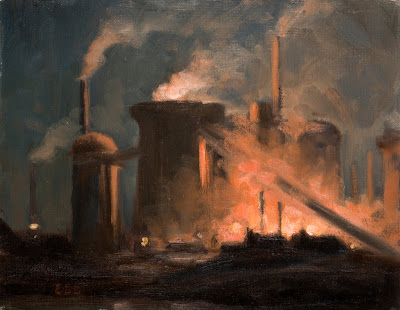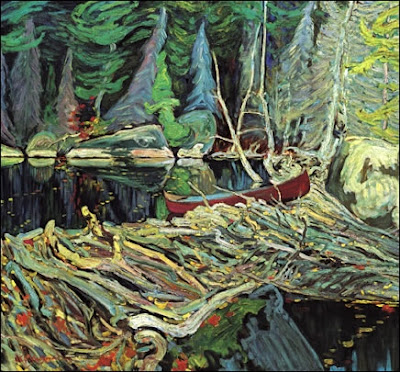I’m obsessed
with cambered tarmacs, concretes,
the washings of rain.
Roy
Fisher, excerpt from his poem, ‘Wonders of Obligation’
Roy Fisher, poet
Fisher
has long been seen as an ‘outsider’ in the UK poetry and literary establishment
(he is also a Jazz musician), and gained early recognition in the US. Interestingly,
it was because of the negative
connotations for outsiders of "Birmingham" that the city's name did
not once appear in Fisher’s early long poem City, which seems to sum up a lot of attitudes
towards the second city that I’m sure all its residents have experienced from
outsiders at some point. I know I have. But if you think that is bad, try
telling people you come from the Black Country.
Especially to a Brummie! I’ve experienced that too, and my Dad, Tipton
born and bred, holds a great deal of resentment towards Brummies even now,
which is a common feeling in the Black Country. This stems from his experiences
of working in factories alongside men from Birmingham in the 60’s, and
constantly being talked at by the Birmingham workers as if he was an idiot because of his thick
accent, and being accused of nicking their tools, which the Birmingham workers
would not share with their fellow workers from across the Black Country border. Somehow, to
come from the Black Country is to always be seen as ‘outside’.
Edwin Butler Bayliss, 'Furnaces', 1920 approx
I felt I could
sense some of this funnily enough in the paintings of Edwin Butler Bayliss that
are currently on display at Wolverhampton Art Gallery. His paintings of the
Black Country landscape at the height of its heavy industrial past, are all
dark, tall chimneys and scudding smoke, and are being celebrated there in a
major exhibition of this artist’s work.
Although I found much to enjoy in the paintings when I visited, I
couldn’t help but feel they didn’t deserve this sort of attention, and were
typical of this period of nineteenth century painting, owing more to France
than Tipton. Bayliss was the son of a wealthy local factory owner, and for me
the lack of any meaningful portrayal of the workers in these forges and
furnaces, apart from a few anonymous figures seen from the back furtively moving
across the landscape, who were more often than not working in the most
appalling and dangerous conditions, was troubling. I guess his subject was the
ravaged and melancholy Black Country landscape, but it served to create a
somewhat disturbing ‘distance’ from the reality of the subject and the lives of
the people working in Bayliss’s family factory. My own family, from my Dad and
his brothers who all worked in factories like their Father, my grandad, and my
grandmother’s brothers who all worked in the local mines, they all worked in places like these and have
dark tales to tell. These paintings stirred in me an uneasy sense of
alienation.
Alongside Bayliss’s
works, in an adjoining room, were a selection of current interpretations of the
Black Country by members of the RBSA. Please feel free to shoot me if I ever
make anything like this in my portrayal of the edglands landscape. My A level students make more exciting work.
Slade in 'Flame'
I recently
watched ‘Slade In Flame’, the 70’s movie starring the famous Black Country
rockers, and despite it actually being filmed in Nottingham and Sheffield, I
noticed as the credits rolled up, it
reminded me more of the industrial region that I grew up in. This was something
to do with the black and dry gallows humor of Noddy Holder (who was great) and
the band, and the other supporting cast that reminded me a great deal of the
characters I grew up around that my Dad worked with. But what a bleak and
dispiriting film it was too! It was an incredibly cynical tale of the perils
and the reality of fame for a rock ‘n’ roll band in this era that left me quite
numb as it rather abruptly ended, almost as if the filmmakers had become too
jaded themselves to carry on with this story any longer than strictly
necessary.
Tom Thomson, 'Tamaracks', oil on board
I
have also recently read ‘Painting Canada: Tom Thomson and The Group of Seven’,
an extensive catalogue for the recent exhibition in 2011 of this group of
painters at Dulwich Picture Gallery, which I sadly failed to get to. I opted
for Richter at the Tate instead, but think I may have got more from the
paintings of these guys, which are pretty new to me. I think it would be too
much to describe their work as innovative or as important when compared to others of the period in Europe who they were greatly
influenced by, such as the Post-Impressionists, the Expressionists and Munch,
but I have really enjoyed the many strengths and qualities to be found in these
often dynamic and colourful canvasses. Thomson’s small ‘plein air’ paintings
have a special intense and dense quality that lifts them to another level, that
I think is lost a little when they are developed into the studio pieces. I had
a similar comment levelled about my own work at Rugby recently, which compared the
energy in a smaller piece to a larger painting of the same motif where the
person felt the energy had become ‘dissipated’. ‘Plein Air’ studies are always
going to possess a certain quick, spontaneous energy by the very nature of how
they are made. Many people prefer
Constable’s oil sketches for the same reason, and it was also commented on at
the recent Thomas Fearnley exhibition at the Barber Institute, but the studio
pieces are often something else entirely. But still, it is an issue I have been
considering since the Rugby exhibition, but more in relation to scale, and have
been working on many smaller pieces on the studio since in pastel and oil on
paper.
Coincidently,
the Group Of Seven were greatly influenced by an exhibition of Contemporary
Scandinavian Art held in New York in 1912, and shared an affinity with their
‘fondness for great, open spaces and the magic radiance of the arctic aurora’,
and ‘an exhilarating sense of direct communication with nature and natural
forces’. It is these qualities that I admire in the Groups’ work and their
relationship with their native Canada, and need to share this with the wider
world as they headed off on their various painting expeditions. Here is a good
example by J.H McDonald in his ‘Beaver Dam’ painting of 1919. I also really
like Lawren Harris’s stylised paintings of icebergs and mountains, which in
their stylization possess an austerity that I find appealing.
E H McDonald, 'Beaver Dam', oil on canvas
E H McDonald, 'Dam and Birches', oil on canvas
Lawren Harris, 'North Shore, Lake Superior'
McDonald in
writing of the exhibition of Scandinavian art and comparing them with the
Group’s ideals wrote, ‘The painters began with nature rather than art’. My own
responses to landscape with my recent motorway paintings have begun the other way
around, they are more about art than nature. I’ve been trying to bring the two
areas closer together with my own Scandinavian work.
There seems to be an ‘outsider’ theme to this post, and that seems to be the theme that is emerging from my Scandinavian work as I start to get deeper into it. The experience we had in Norway, and the feelings of abandonment we felt, coloured the whole trip, and also left me questioning my relationships with people. As I’ve worked on these pieces in the last few months, I keep coming back to these issues and my own persistent sense of being an ‘outsider’…
There seems to be an ‘outsider’ theme to this post, and that seems to be the theme that is emerging from my Scandinavian work as I start to get deeper into it. The experience we had in Norway, and the feelings of abandonment we felt, coloured the whole trip, and also left me questioning my relationships with people. As I’ve worked on these pieces in the last few months, I keep coming back to these issues and my own persistent sense of being an ‘outsider’…













No comments:
Post a Comment